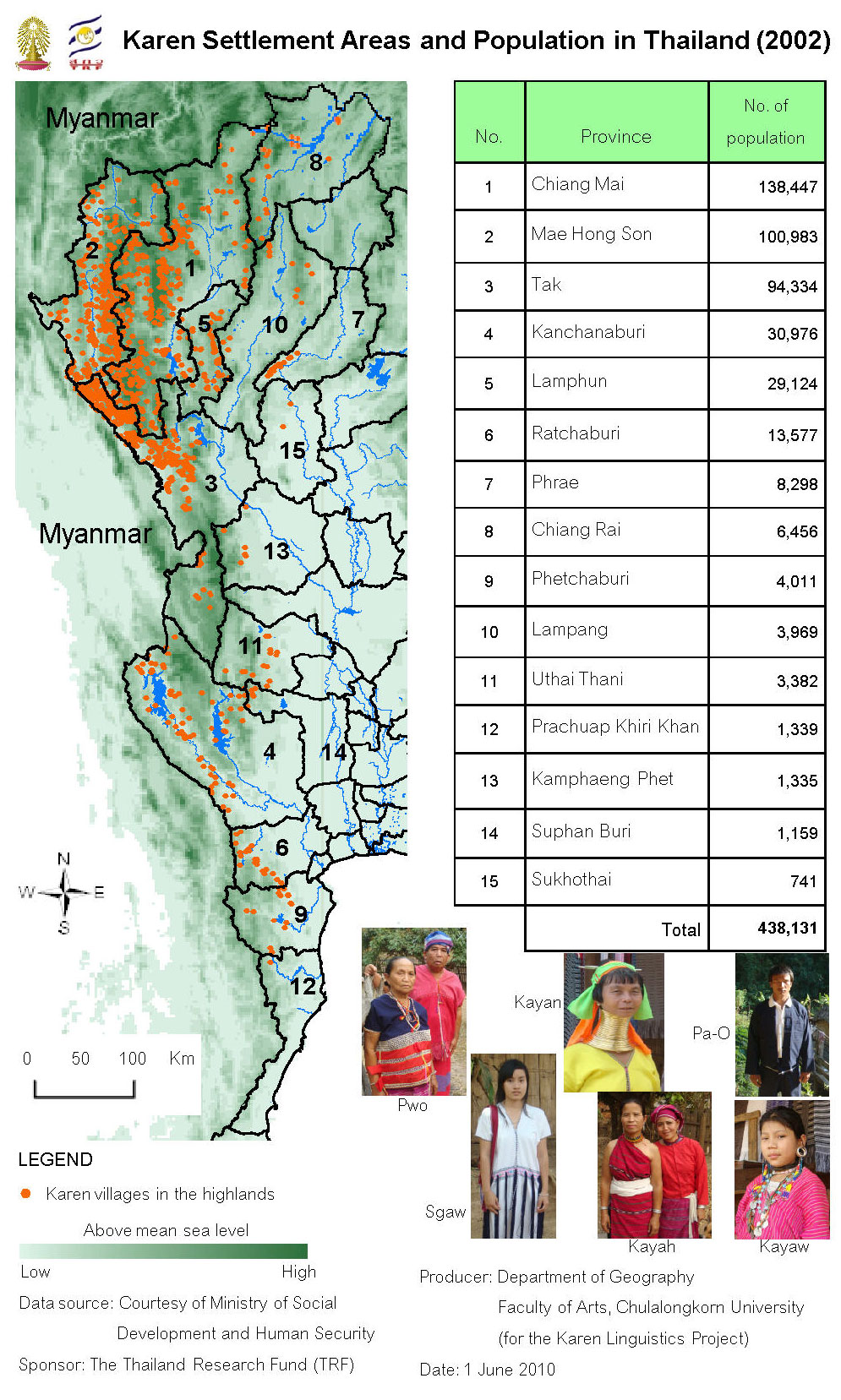โครงการภาษาศาสตร์ภาษากะเหรี่ยง
แนะนำโครงการ
กะเหรี่ยงเป็นชนพื้นเมืองดั้งเดิมของเอเชียตะวันออกเฉียงใต้แผ่นดินใหญ่ ตั้งถิ่นฐานเป็นแนวยาวจากเหนือลงใต้ในเขตต่อแดนไทยพม่าตั้งแต่สมัยก่อนประวัติศาสตร์ ในประเทศพม่ามีจำนวนประชากรกะเหรี่ยงประมาณ 3.7 ล้านคน (Ethnologue) ในประเทศไทยมีประชากรกะเหรี่ยงประมาณ 5 แสนคน ชาวกะเหรี่ยงในประเทศไทยแบ่งออกเป็นกะเหรี่ยงที่อาศัยอยู่ในประเทศไทยเป็นเวลาช้านานมาแล้ว และบางส่วนได้ผสมกลมกลืนกับคนไทยทั่วไป ส่วนใหญ่เป็นกลุ่มกะเหรี่ยงโปหรือโผล่ง (Pwo/Phlong) กับกลุ่มกะเหรี่ยงสะกอหรือปากะญอ (Sgaw/Paganyaw) อีกส่วนหนึ่งเป็นกลุ่มที่อพยพเข้ามาอยู่ใหม่ด้วยเหตุผลบางประการ อาทิ ความอดอยาก สงครามภายในประเทศพม่า พวกธุรกิจท่องเที่ยวพาเข้ามา ฯลฯ กลุ่มที่เพิ่งอพยพเข้ามาใหม่ ได้แก่ กลุ่มปะโอหรือตองสู (Pa'O/Tongthu) กะยา (Kayah) กะยัน (Kayan) หรือกะเหรี่ยงคอยาว และกะยอ (Kayaw) หรือกะเหรี่ยงหูใหญ่
เนื่องจากชาวกะเหรี่ยงเป็นกลุ่มชาติพันธุ์ที่พูดภาษาตระกูลจีน-ทิเบต (Sino-Tibetan) ที่มีวิถีชีวิตความเป็นอยู่ ความเชื่อ ประเพณี พิธีกรรม รวมทั้งการแต่งกายที่น่าสนใจ เท่าที่ผ่านมา จึงมีการศึกษาค้นคว้าทั้งแนววิชาการที่เป็นความรู้เบื้องต้น และแนวสารคดีเกี่ยวกับกลุ่มชาติพันธุ์กะเหรี่ยงที่ให้ทั้งความรู้และความบันเทิง ซึ่งสามารถหาอ่านได้จากเอกสารสิ่งพิมพ์นานาประเภทและจากเว็บไซต์ต่าง ๆ อย่างไรก็ตาม การศึกษาค้นคว้าวิจัยเกี่ยวกับภาษากะเหรี่ยงแนวภาษาศาสตร์ในช่วง 50 กว่าปีที่ผ่านมา จากบรรณานุกรมคัดสรร (Manson, 2004) จะเห็นได้ว่ามีผลงานวิจัยภาษากะเหรี่ยงด้านกลสัทศาสตร์เพียง 1 รายการ (Abramson, 1995) นอกจากนั้นเป็นด้านภาษาศาสตร์พรรณนา และด้านภาษาศาสตร์เปรียบเทียบและเชิงประวัติซึ่งพอมีบ้าง แต่ก็เป็นผลงานที่ใช้แนวคิดทฤษฎีภาษาศาสตร์แบบเก่า
นอกจากนี้ ยังมีคำถามเกี่ยวกับประโยชน์ทางอ้อมอันเป็นผลลัพธ์ (outcome) ของการศึกษาวิจัยเกี่ยวกับภาษาของชาวกะเหรี่ยงที่อาศัยอยู่ในจังหวัดแม่ฮ่องสอนซึ่งเป็นพื้นที่หลักของการวิจัยและจังหวัดอื่นๆ ทางด้านตะวันตกของประเทศไทย ว่าจะสามารถเสนอแนะมุมมองด้านนโยบายการพัฒนาชุมชนกะเหรี่ยงอย่างยั่งยืน และการส่งเสริมการท่องเที่ยวของจังหวัดที่มีกลุ่มชาติพันธุ์กะเหรี่ยงเป็นจุดขายโดยเน้นศักดิ์ศรีของความเป็นคนที่มีจิตวิญญาณและศิลปวัฒนธรรมของชาวกะเหรี่ยงได้หรือไม่และอย่างไร
โครงการ "ภาษาศาสตร์ภาษากะเหรี่ยง" มีวัตถุประสงค์ดังนี้
- เพื่อวิเคราะห์ภาษากะเหรี่ยง 6 กลุ่ม ได้แก่ สะกอ โป ปะโอ กะยา กะยัน และกะยอ ด้านกลสัทศาสตร์ สัทวิทยา รวมทั้งภาษาศาสตร์เปรียบเทียบและเชิงประวัติในแง่มุมที่ยังไม่เคยมีการศึกษาวิจัยมาก่อน โดยใช้ประเด็นปัญหาทางภาษาศาสตร์ที่ต้องการหาคำตอบเป็นสำคัญและนำเสนอผลการวิจัยเป็นบทความภาษาอังกฤษ
- เพื่อจัดทำหนังสือ 2 ภาษา ไทย-อังกฤษ ประกอบภาพ "เรื่องเล่าจากชายแดนไทย-พม่า: ประกายไฟเพื่อการพัฒนาแบบยั่งยืน" เสนอแนะมุมมองด้านนโยบายการพัฒนาชุมชนและการท่องเที่ยวของจังหวัดที่มีคนกะเหรี่ยงอาศัยอยู่ ในการดำเนินเรื่อง จะเน้นกลุ่มชาติพันธุ์กะเหรี่ยงรวมทั้งโครงการส่วนพระองค์และโครงการในพระราชดำริที่เกี่ยวข้องกับการพัฒนาคุณภาพชีวิตของคนกะเหรี่ยง
- เพื่อช่วยสร้างเสริมความเข้าใจอันดีระหว่างชนในชาติ ซึ่งมีความหลากหลายด้านภาษาและวัฒนธรรม โดยใช้กลุ่มชาติพันธุ์กะเหรี่ยงเป็นกรณีตัวอย่าง ตามแนวทางของนักภาษาศาสตร์ที่เชี่ยวชาญด้านภาษาศาสตร์ภาคสนามเพื่อแสดงให้เห็นว่า "นักภาษาศาสตร์ก็ช่วยชาติได้"
การวิจัยครั้งนี้ได้ใช้วิธีวิจัยแนวผสมผสาน คือ สำรวจและสังเคราะห์ข้อมูลจากเอกสารที่เกี่ยวข้อง เก็บข้อมูลภาคสนามโดยการสัมภาษณ์ผู้บอกภาษากะเหรี่ยง ณ จุดเก็บข้อมูลที่จะกำหนดขึ้นภายหลังจากที่ได้ติดต่อประสานงานกับบุคคลและหน่วยงานทั้งภาครัฐและเอกชน เพื่อหาความเหมาะสมด้านวิชาการ การเดินทาง และความปลอดภัย ด้านการวิเคราะห์จะวิเคราะห์ข้อมูลทางกลสัทศาสตร์โดยใช้อุปกรณ์และโปรแกรมคอมพิวเตอร์ รวมทั้งใช้แนวคิดทฤษฎีและกรอบความคิดทางภาษาศาสตร์ที่เหมาะสมกับงานวิจัยแต่ละหัวข้อ
Introduction of the Project
The Karen people, an indigenous ethnic group of the mainland of South East Asia, have established their settlements, from North to South, along the Thai-Burmese border since the pre-historic period. The population of this ethnic group in Burma is approximately 3.7 million (Ethnologue) and about 500,000 in Thailand. The Karen in Thailand are categorized into two groups. The first group has been here for a long time and some have thus become assimilated into the Thai way of life. These are the Pwo or the Phlong and the Sgaw or the Paganyaw. The second group consists of those who have recently migrated to Thailand for different reasons — fleeing from famine or the political unrest in Burma or being led into Thailand by people in the touring business. These are the Pa'O or the Tongthu, the Kayah, the Kayan or the Long-Necked Karen and the Kayaw or the Large Ear-lobed Karen.
The Karen belong to those ethnic groups that speak the Sino-Tibetan language; their way of life, beliefs, customs, traditions, rituals and rites as well as their costumes are unique. Academic research and studies have been conducted to provide background knowledge on these features and can be accessed through documentaries, various types of publication and websites, which have been created for academic and entertainment purposes. However, a selected bibliography (Manson, 2004) shows that, during the past fifty years, there has been only one piece of research on the acoustics of the Karen languages (Abramson, 1995); other studies relate to descriptive, comparative or historical linguistics, which are based on traditional linguistic theory.
Some questions are raised about any indirect benefit that may result from the outcome of research into the language spoken by the Karen in Mae Hongson Province and other provinces in the West of Thailand — whether the project will be able to propose a policy for the sustainable development of the Karen Community and whether it will be able to promote tourism in the provinces, using the Karen ethic group as a strategic business plan to promote tourism, while at the same time, enhancing their human dignity; their heart and soul as well as their art and culture.
The following are the objectives of the "Linguistics of the Karen Language" Project.
- To analyze, in terms of the vowel system and acoustics, six groups of Karen languages; namely, the Sagaw, the Pwo, the Pa'O, the Kayah, the Kayan and the Kayaw, as well as to carry out comparative and historical studies in aspects that have never been pursued before in the field of linguistics, relying on linguistic problems that need to find answers. The research findings will be published in English in the form of articles.
- To publish a book, with illustrations, in Thai and English, Stories from the Thai-Burmese Border Area: Sparks for Sustainable Development in order to present a perspective on a policy for the development of community and tourism in the provinces where the Karen live. The stories will be presented with emphasis on the Karen ethnic groups, Her Royal Highness Princess Maha Chakri Sirindhorn's private projects and the projects organized by her initiatives that aim to improve the Karen's quality of life.
- To promote a better understanding among the different groups of people in the nation, who vary in language and culture, using the Karen as a case-study. The study will be conducted within the guidelines of linguists specializing in linguistic field work to demonstrate that "linguists can also contribute to the development of the country".
This research will rely on a mixed methodology, which involves the survey and analysis of information from related documents and field work involving interviews with Karen informants in areas that will be specified later after contact has been made with people, governmental and private units in order to ensure the academic appropriateness and safety of the field trips. The analysis of acoustic information will be based on instruments and computing programmes, as well as the linguistic theory and framework appropriate to each of the research topics.



